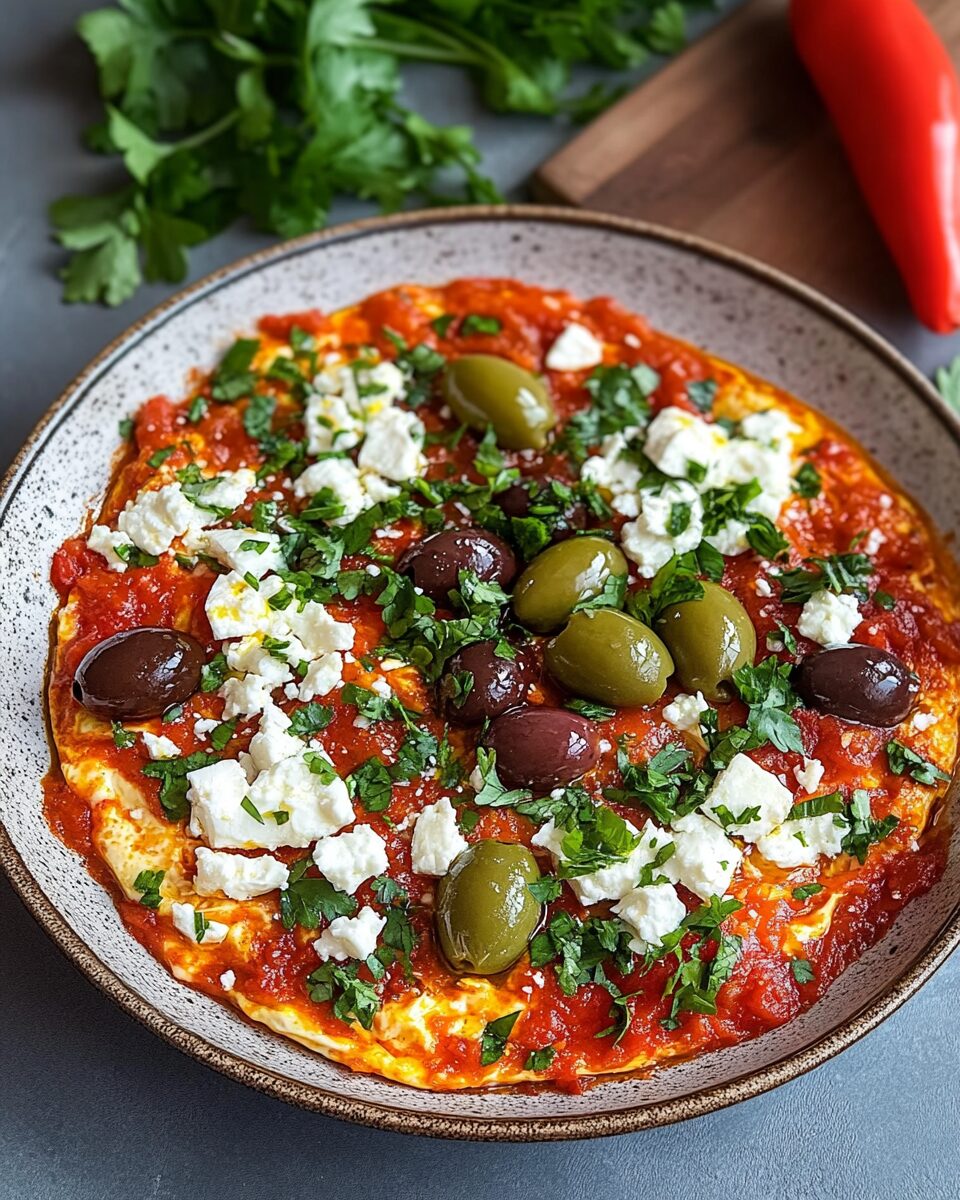The vibrant combination of runny poached eggs, bold spices, briny olives, and creamy feta creates a mouthwatering shakshuka that feels like a warm hug from the Mediterranean. Whether you’re planning a cozy breakfast in bed or an easy weeknight meal, this dish delivers on comfort and flavor.
Served straight from the skillet and loaded with color and texture, this shakshuka recipe is perfect for dipping fresh bread and sharing with friends or family. It’s flexible enough for brunch gatherings, yet simple and quick enough to pull together when time is short and hunger is high.
Full Recipe:
-
2 tablespoons olive oil
-
1 teaspoon smoked paprika
-
1 teaspoon ground cumin
-
1/4 teaspoon Aleppo pepper flakes (or 1/8 tsp crushed red pepper flakes)
-
1 large yellow onion, halved and thinly sliced
-
2 cloves garlic, thinly sliced
-
1 red bell pepper, seeded and thinly sliced
-
1 yellow bell pepper, seeded and thinly sliced
-
1 can (28 oz) whole peeled tomatoes (preferably San Marzano)
-
1/2 teaspoon salt (adjust to taste)
-
4 ounces feta cheese, crumbled
-
1/3 cup pitted Kalamata olives
-
4 large eggs
-
1/4 bunch cilantro, chopped (for garnish)
Directions:
-
Heat olive oil in a large skillet over medium heat. Add paprika, cumin, and Aleppo pepper. Bloom spices for about 1 minute.
-
Add sliced onion and cook for 3 minutes, stirring occasionally.
-
Add garlic and bell peppers. Cook for about 15 minutes, until soft.
-
Crush the tomatoes by hand in a bowl. Add to skillet with salt. Simmer for 5 minutes.
-
Create 4 small wells in the sauce using a spoon. Crack an egg into each well.
-
Sprinkle feta and olives around eggs. Cover skillet and cook for 8 minutes, or until egg whites are set and yolks are still runny.
-
Garnish with chopped cilantro and a pinch of red pepper flakes. Serve hot, straight from the pan with crusty bread or pita.
Prep Time: 10 minutes | Cooking Time: 25 minutes | Total Time: 35 minutes
Kcal: 313 kcal | Servings: 4 servings
The Allure of Shakshuka: A Mediterranean Classic
Shakshuka is more than just a trendy brunch item—it’s a soulful, one-pan meal deeply rooted in culinary traditions that span across continents. This vibrant dish of poached eggs nestled in a spiced tomato and pepper sauce has become a global comfort food, and the version with feta, olives, and peppers offers a Mediterranean twist that’s both rich in flavor and history. While it’s incredibly simple to prepare, its flavors are anything but.
A Dish with Deep Roots
The origins of shakshuka are widely traced to North Africa—particularly Tunisia, Libya, and Algeria—where tomatoes, peppers, and spices like cumin and paprika form the basis of many traditional dishes. The name “shakshuka” is thought to mean “a mixture” in Arabic, aptly describing its hearty combination of ingredients.
As this humble dish traveled eastward, it became a beloved staple in the Middle East, especially in Israel where it’s now a national breakfast favorite. Its popularity spread through Jewish and Arab kitchens, finding a place in both everyday meals and celebratory spreads.
What makes shakshuka so universally loved is its adaptability and the comforting balance of flavors and textures—rich tomato sauce, softly cooked eggs, savory additions, and fresh herbs.
Feta and Olives: A Mediterranean Upgrade
While the base of shakshuka usually includes tomatoes, garlic, onions, and spices, the addition of feta cheese and Kalamata olives introduces a distinctly Mediterranean profile. These ingredients enhance the umami of the dish, balancing the sweetness of bell peppers and the acidity of tomatoes with briny, salty complexity.
Feta cheese not only adds creaminess but also a touch of tang that pairs beautifully with the smoky undertones from paprika and the richness of the eggs. Kalamata olives, known for their bold and fruity taste, punctuate the dish with little bursts of flavor. These two ingredients elevate the shakshuka from a rustic stew to a more decadent and layered culinary experience.
The Role of Peppers in Shakshuka
Colorful bell peppers—typically red and yellow in this variation—contribute both sweetness and texture. They also give the dish its characteristic depth, rounding out the sharper tones of tomatoes and balancing the spice level. Cooking the peppers slowly helps them break down and meld into the sauce, which becomes the perfect poaching medium for the eggs.
Aside from flavor, the peppers provide visual appeal, making the dish more vibrant and inviting. Their natural sweetness contrasts well with the salty feta and olives, creating a symphony of complementary tastes.
Why Eggs are Poached, Not Scrambled
At the heart of shakshuka are the eggs, which are poached gently in the simmering sauce. This cooking method allows the whites to set while the yolks remain runny—a crucial feature for many shakshuka lovers. The runny yolks act as a rich, creamy sauce that blends with the tomato mixture when broken.
Unlike other egg-based dishes like scrambled eggs or frittatas, shakshuka eggs are meant to be the centerpiece, not just a protein source. They are delicately handled to preserve their integrity and offer a luscious contrast to the rustic sauce. The stovetop method of poaching gives the cook more control over doneness, avoiding the risk of overcooked yolks that can happen in oven-based methods.
Health and Nutrition Benefits
Shakshuka is not only delicious—it’s also nutritious. This dish is naturally vegetarian and packed with vitamins, antioxidants, and protein. Tomatoes and bell peppers are excellent sources of vitamin C, potassium, and lycopene—a powerful antioxidant linked to heart health and cancer prevention.
Eggs provide high-quality protein and essential nutrients like choline, B vitamins, and healthy fats. Adding feta introduces calcium and more protein, while olives contribute heart-healthy monounsaturated fats.
Despite its hearty feel, shakshuka can be a low-calorie meal depending on portion sizes and sides. One serving generally offers a balanced combination of macronutrients, making it suitable for breakfast, lunch, or dinner.
Cultural Versatility and Global Popularity
One of the most fascinating aspects of shakshuka is its global reach. Its simplicity and versatility have made it popular not only in Middle Eastern and North African households but also in modern cafes and upscale brunch spots around the world.
In Israel, shakshuka is often served with warm challah or pita bread to mop up the sauce. In Tunisia, it might come with spicy merguez sausage. Across Europe and the United States, it’s become a go-to vegetarian option that can easily be adjusted to suit local palates and ingredient availability.
Its universal appeal lies in its ability to straddle comfort and sophistication. Whether served in a rustic cast-iron skillet or plated elegantly in a high-end restaurant, shakshuka speaks to people across cultures.
Variations to Try at Home
Shakshuka is endlessly customizable, which adds to its charm. Here are a few popular variations:
-
Green Shakshuka: Made with herbs, leafy greens like spinach or kale, and sometimes cream or cheese for richness.
-
Spicy Harissa Shakshuka: Incorporates the North African chili paste harissa for heat and depth.
-
Pesto Shakshuka: Swirls of pesto add brightness and herbaceous character.
-
Chickpea Shakshuka: Adding chickpeas for extra protein and a hearty twist.
-
Vegan Shakshuka: Use tofu or chickpea flour “eggs” for a fully plant-based version.
You can also experiment with toppings—labneh, avocado slices, or even pickled onions can enhance the experience.
Serving Suggestions
Shakshuka is best enjoyed hot and straight from the pan. Crusty bread or pita is a must for scooping up the luscious sauce. It can also be served with a side salad for a more complete meal.
If you’re serving it for brunch, a refreshing cucumber yogurt dip or a citrusy arugula salad balances the warmth of the dish. For dinner, consider pairing it with roasted potatoes or couscous.
The communal nature of shakshuka makes it perfect for sharing, and it’s always a crowd-pleaser, whether you’re hosting brunch, entertaining guests, or feeding the family.
Tips for Perfect Shakshuka
-
Use high-quality canned tomatoes: San Marzano tomatoes are often recommended because they break down well and have a naturally sweet, rich flavor.
-
Cook the vegetables slowly: This develops their natural sweetness and allows the flavors to meld.
-
Crack eggs into a cup before adding: This helps avoid shell fragments and gives you more control over placement.
-
Don’t rush the eggs: Keep the lid on and monitor the eggs closely to avoid overcooking the yolks.
-
Garnish generously: Fresh herbs like cilantro or parsley brighten up the dish and add a final layer of flavor.
Conclusion
Shakshuka with feta, olives, and peppers is a celebration of bold flavors, wholesome ingredients, and culinary heritage. It’s a dish that’s as suitable for a quiet breakfast at home as it is for a festive brunch with friends. With just one pan, a handful of fresh ingredients, and a little bit of time, you can recreate this timeless dish that brings warmth, nourishment, and joy to any table.
Whether you’re honoring its North African roots or adding your own twist, shakshuka is proof that simple food can be spectacular. It invites creativity while offering the grounding familiarity of home-cooked comfort. Try it once, and it may just become a staple in your kitchen for years to come.






